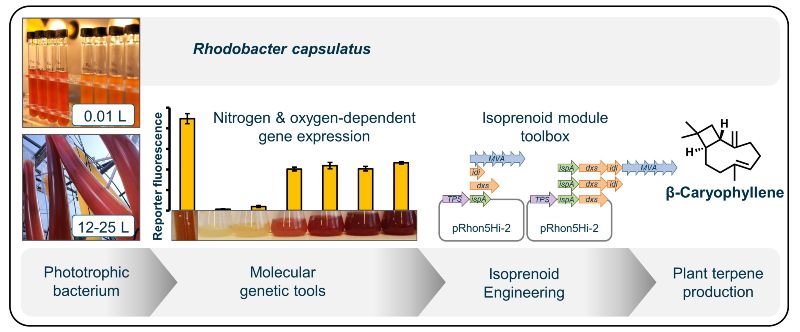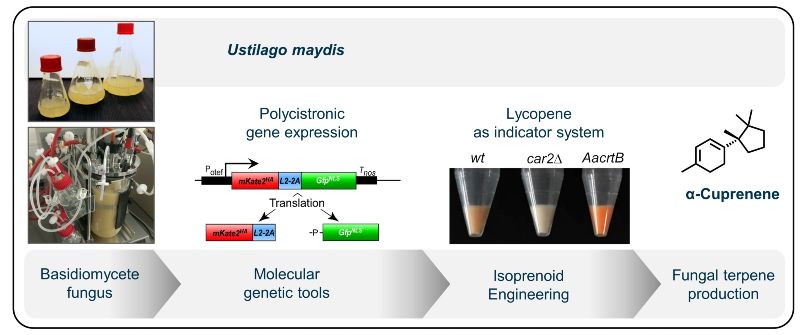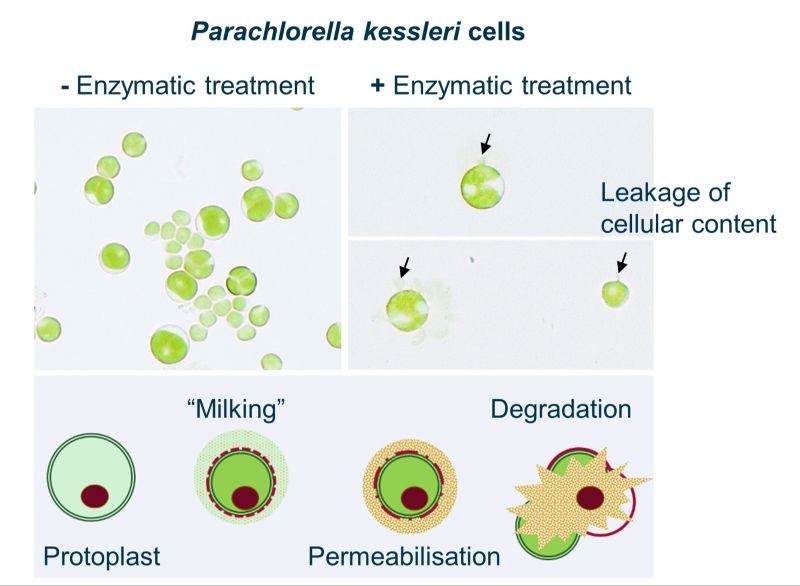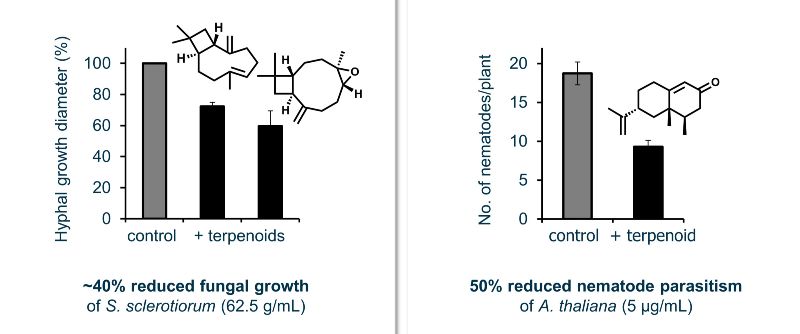Terpenoids are the largest and most diverse class of natural products, which occur in all kingdoms of life. They are composed of C5 isoprenoid units, which are elongated and typically cyclized to a multitude of molecular scaffolds. Especially plants but also fungi seem to have evolved compounds with specific ecological functions and bioactivities, which are applicable as nature-inspired agents for agricultural control of plant pests. Therefore, the sustainable production of terpenoids in microbial hosts to obtain access to this biochemical wealth is one focal point of present-day biotechnology.
We have thus developed the bacterium Rhodobacter capsulatus and the fungus Ustilago maydis as microbial terpene production hosts to complement well-established platforms like Saccharomyces cerevisiae and Escherichia coli. The bacterium R. capsulatus is able to fix atmospheric CO2 and N2 and can be cultivated in the lab or, at larger scale, utilising sun light as an energy source. It can form a highly enlarged intracytoplasmic membrane system, which may constitute a particularly suitable reservoir for membrane-embedded enzymes and hydrophobic compounds of terpenoid pathways. Utilising host-specific expression tools, we engineered the intrinsic isoprenoid metabolism and introduced a second non-native route to channel more C5 building blocks in the pathway. This enabled installation of an optimal isoprenoid level for conversion by different recombinant terpene synthases, resulting in the production of diverse sesquitepenes including (+)-valencene and (‑)‑patchoulol, as well as di-, tri- and tetraterpenes at titers up to > 0.1 g/L. Hence, we corroborate that Rhodobacter species can serve as microbial cell factories for the production of terpenoids.

The fungus U. maydis, a relative of the fruiting body-forming mushrooms, can be grown like a yeast in the lab and is genetically accessible. Despite its biotechnological relevance and long-time research, only few of the advanced methods provided by synthetic biology are available for use in Ustilago. Therefore, we set to establish a broad toolbox of synthetic biology molecular elements for the fungus. These range from genetic elements for the multiplex expression of genes and quantitative reporters up to chemically inducible systems and the first optogenetic tools. We have further engineered U. maydis to produce high levels of glycolipids, which belong to its native biosynthetic repertoire and are useful as bioactive and surface active compounds. For newly establishing recombinant terpenoid production in the host, we used the intrinsic formation of carotenoids as a coloured indicator system of isoprenoid levels. This facilitated following the effects of engineering of the isoprenoid metabolism and of introducing a heterologous terpenoid pathway. We produced (+)-valencene and α-cuprenene by expression of a plant and a fungal terpene synthase, respectively, the latter leading to a ca. tenfold higher titre of about 0.1 g/L. We thus demonstrate for the first time that U. maydis can serve as promising novel chassis for the production of terpenoids. In addition, we screened extracts of fruiting body-forming mushrooms for bioactivity against fungi. We identified the novel antifungal polyyne Feldin from the fungus Fistulina hepatica. Interestingly, the related fungus U. maydis exhibits increased resistance against Feldin. This lays the foundation to use U. maydis as future production host.

The group of microalgae has gained increasing market potential and particularly high consumer acceptance as a source of health promoting food, sustainable feed and platform chemicals. Moreover, they can be employed in the efficient mitigation of anthropogenic CO2-, nutrient- and pollutant-emissions. Therefore, we have revisited the phylogenetic classifications and characteristics of commercialised Chlorellaceae strains. Moreover, we have addressed the permeabilisation of the microalgal cell wall, which represents a major physical obstacle hampering their effective utilisation including genetic engineering and optimisation in the sense of synthetic biology. We thus developed a gentle enzymatic treatment as a novel approach. Potential applications include the “milking”, i.e. a continuous non-destructive extraction of products from cells and the molecular genetic manipulation. Hereby, we established a novel approach for permeabilisation of microalgae, which has the potential, as key enabling technology, to catalyse scientific progress for their sustainable utilisation including terpenoid production.


Bioactivity analysis of terpenoids elucidated a range of effects against plant pathogens. Some terpenoids showed activity against phytopathogenic fungi like white mold-causing Sclerotinia sclerotiorum. One terpenoid in particular significantly reduced plant infestation with the parasitic nematode Heterodera schachtii, which severely infects crops like rapeseed and sugar beet. Here, we found that the compound exerts the effect by triggering the plant defence system. Our interdisciplinary studies thus demonstrate that urgently needed bioactive compounds are yet to discover in the plethora of terpenes, which have the potential to be developed into novel plant protection agents.
Our efforts thus directly addressed some key challenges of the field, i.e. production improvement and accessing diverse compounds. The latter is granted by functional expression of diverse terpene synthases, which introduce an enormous structural diversity at this point of the biosynthetic pathway. The necessary expression tools were established and further utilized to adapt precursor biosynthesis levels, which was identified as essential success factor. Importantly, the development of multiple host platforms appears crucial for exploitation of the naturally wide chemical space of the plethora of terpene compounds.
Prof. Karl-Erich-Jaeger
Dr. Anita Loeschcke
Dr. Thomas Drepper
Robin Weihmann
Fabienne Hilgers
Institute of Molecular Enzyme Technology
HHU Düsseldorf
Prof. Michael Feldbrügge
Dr. Kerstin Schipper
Junho Lee
Peter Stoffels
Microbiology
HHU Düsseldorf
Prof. Matias D. Zurbriggen
Nicole Heucken
Lisa Hüsemann
Synthetic Biology
HHU Düsseldorf
Prof. Jochen Büchs
Dr. Nina Ihling
Carl Brehl
Biochemical Engineering (AVT.BioVT)
RWTH Aachen University
Prof. Ulrich Schurr
Dr. Holger Klose
Dr. Diana Reinecke-Levi
IBG-2 - Plant Science
Forschungszentrum Jülich
Prof. Florian Grundler
Dr. Sylvia Schleker
Dr. Samer Habash
INRES – Molecular Phytomedicine
University of Bonn